The College and University industry market size, measured by revenue, was $818.6 billion in 2023. And according to research from SimpsonScarborough, the average institution spends between $29 and $263 on marketing for each enrolled student.
With the market value so high, colleges and universities face competition to attract and secure admissions from prospective students. Institutions need to develop strategies that differentiate them from competitors and attract students into their programs.
This article will review the top trends in higher education marketing and some actionable tips to try out today. An organized student marketing strategy can expand geographical reach, boost enrollment numbers, and increase alumni engagement.
📑 Table of Contents
-
- Incorporating TikTok Marketing
- Utilizing Text Message/SMS Communication
- Using Instagram and Instagram Advertising
- Authenticity Over Polished and Salesy
- Using YouTube for Long-Form Video Content
- Repurposing Long-Form Videos with Short-Form Videos
- Running Paid Social Campaigns
- Utilizing First-Party Data
- Using Lookalike Audiences
- Being Conversational
- Collaborating with Student Ambassadors
- Using an Enrollment Funnel
- Hosting Hybrid Events
The Top 13 Trends in Higher Education Marketing To Motivate Your Campaigns
Around 97% of Gen Z uses social media to learn about new products. This presents an interesting opportunity for universities to promote their programs, campus life, student experiences, and other relevant aspects.
What is higher education marketing?
Higher education marketing isn’t flashy marketing tactics to lure students in. Rather, it’s about positioning the university in a way that attracts the right prospective students, answers their questions, and showcases its programs, facilities, faculty, and unique offerings to prospective students.
To reach this technologically advanced generation, let’s review 13 trends in higher education to help you devise your marketing strategies.
⚡ Gen Z, born between 1997 and 2012, accounts for 2.1% of the United States population.
1. Incorporating TikTok Marketing
Due to its flexibility and universality, TikTok marketing for higher education may become the most dominant marketing form.
Gen Z spends more than 5 hours daily on the app, making it an easy choice for university marketers.
Universities can use TikTok to show campus tours, highlight the athletics program and campus health and safety, and share student-generated content, including alumni success stories.
Boston University’s TikTok features a variety of content, including student achievement highlights across all academic disciplines. It also promotes special events like the Beanpot Hockey Tournament, and especially tries to capture its students’ experiences, challenges, and moments as they engage in campus life.
@bostonu Watch as #TerrierCreator @laura chaustre (Questrom’26) showcases what it’s like to participate in a BU Study Abroad summer program in Paris, France. #dayinmylife #dayinthelife #bostonuniversity #collegelife #college #studyabroad
In this video, a student took over the Boston University TikTok to show her day in the life of studying in Paris, France.
💡 Higher Education TikTok Marketing Tip:
Gen Z likes to stay updated with the latest TikTok songs and trends, so universities should stay current. TikTok also ranks this content higher in its algorithm.
TikTok trends fade fast (about 3 to 5 days), so post your content promptly, or it’ll be history.
🏫💥 KORTX drove 726 freshmen applications and tracked over 58,000 for a college enrollment campaign.
Read more about how KORTX’s consultative approach and streamlined First-Party audiences resulted in a nearly 200% increase in admissions leads compared to the previous year.
2. Utilizing Text Message/SMS Communication
Two-thirds of Gen Z favor text messaging over email. Text messaging is an underappreciated trend that will continue to become a dominant communication force.
Also, Gen Z is three times more likely to open a text over an email. For colleges and universities, texting can help position schools as a trusted and valuable resource for prospective students to:
- Communicate important information like enrollment deadlines.
- Invite them to school information sessions.
- Showcase alumni success stories.
- Answer student questions quickly.
- Celebrate admitted students by offering them discounts at the bookshop.
For alumni, institutions can help by sending:
- Job placement text alerts. When a new job opens up, graduating seniors receive a text for relevant jobs in their industry.
- Reunion invites.
- Donation drive messages.
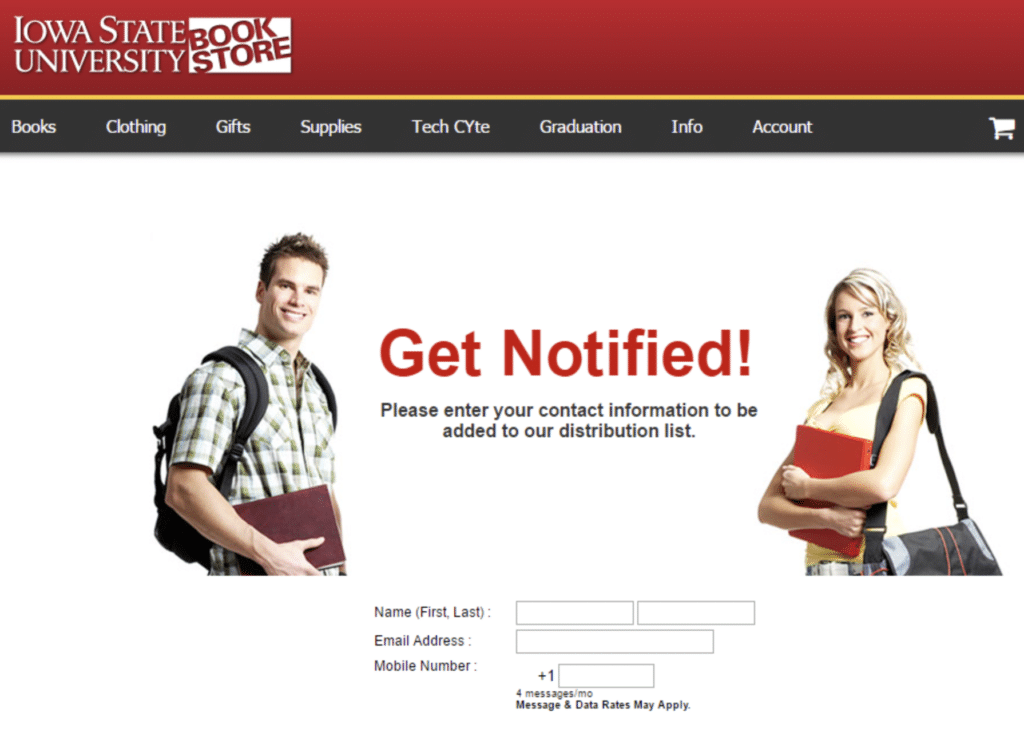
Iowa State University’s library sends SMS promotions and sales alerts to opted-in students for in-store and online purchases.
💡 Higher Education Text Marketing Tip:
Personalize your text communications. Gen Z wants you to show them you know them, with 75% agreeing that personalization is important. Instead of sending generic, one-size-fits-all texts to your audience, take the time to segment your recipients based on their interests, preferences, and stages in the enrollment process.
Use the student’s name in the message and tailor the content to be relevant to their needs.
What challenges are enrollment marketers facing this year?
“Keeping the student in focus with all your marketing work. There are more pressures from university partners and within the enrollment consulting industry to do more with less.
Also, keeping marketing student-focused, authentic, and fresh across all channels, not just email or print, but coordinating across digital, print, email, websites, and ads is always challenging. More now than ever.”

3. Using Instagram and Instagram Advertising
According to Pew Research, 61% of Gen Zers use Instagram daily. Zoomers (another name for Gen Z) prefer to use Instagram over TikTok for socializing.
Only 32% of Gen Z trust the daily ads targeted in their news feeds. However, Instagram’s ads seamlessly blend in with the organic posts, allowing younger users to engage with the platform without feeling overwhelmed by intrusive or disruptive advertisements.
Institutions can also boost existing feed posts to increase engagement and reach. Boston University boosted a current student post, sending it out to their target audience of prospective students ages 16-24.
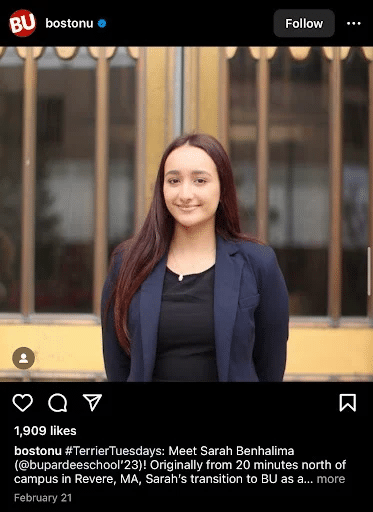
Similar to TikTok, universities can promote brand awareness, campus culture, the campus city life, highlight alumni success, run competitions, and showcase student work through their Instagram pages.
The University of Michigan’s Instagram features alumni success stories to reflect on its mission and school ethos.

It highlights beautiful photos of campus life, and topical themes (like its Mental Health Awareness Month post series) and does an exceptionally good job promoting its diverse student body.
💡 Higher Education Instagram Marketing Tip:
Iconosquare, a social media strategy company, found that between single image, carousel, video, collection, stories, and boosted post ads, single image ads had the most clicks. When running Instagram ad campaigns, combine single-image ads and complement them with a boosted post.
4. Authenticity Over Polished and Salesy
Gen Z prefers real people in ads, with 67% more interested in narratives with realistic depictions of people.
When many social media platforms like Instagram emerged, influencers and brands were quick to curate and create visually stunning content, but Gen Z has resisted this, preferring more raw, less polished content (like blurry photos).
Data from GWI indicates the top three categories Gen Z cares most about from brands is content that is:
- Funny/lighthearted (58%)
- Inspirational (52%)
- Helpful (51%)
Gen Z values authentic content and expects it to align with the platform’s context. Brand assets appearing too polished, sleek, or heavily branded are less likely to perform well on platforms such as TikTok.
The Ohio State University interviews students on its TikTok with its series called #BuckeyeLove. A student, Ally, walks around the campus asking students various personal self-compassionate questions about themselves, like “What do you love most about yourself?”
@theohiostateuniversity We ❤️ these things about you too, Buckeyes! 🤗 #BuckeyeLove
Your university marketers must be connected and influenced by their campuses and the students in them.
💡 Higher Education Authenticity Marketing Tip:
Don’t enhance images or create fictional stories to score authenticity points with students; they will see right through this. Instead, provide opportunities for prospective students to chat with current students with platforms like UniBuddy.
Showcase the perspectives of minority groups and students with unique backgrounds. Feature events and initiatives that promote equity, diversity, and inclusion but ensure it is done authentically without tokenism.
5. Using YouTube for Long-Form Video Content
An online survey found that 96% of Gen Z had a YouTube account. YouTube videos can help expand university awareness and complement other digital marketing campaigns like SEO.
YouTube videos appear in SERPs (search engine results pages), so people can discover an account in many ways.
You can create a branded channel to live stream events like commencement, university updates, school fight songs, feature departmental activities, promote campus tours, advertise, and more.
The University of Houston’s YouTube features a variety of content, like famous alumni like Brené Brown, a popular psychology professor and researcher.

💡 Higher Education YouTube Marketing Tip:
Optimize your video titles, descriptions, and tags. Your YouTube video title should communicate relevant keywords in your messages to existing or prospective students. Always include a primary keyword in your video description.
PPC ads for universities are based on high-performing keywords used in the video description to navigate students to information and admission forms.
🔎 93% of global traffic comes from Google Search.
We’ll use data-driven insights to refine your targeting strategies so you can stretch your marketing budget to get the best results possible.
6. Repurposing Long-Form Videos with Short-Form Videos
While long-form videos are great for in-depth explanations and comprehensive content, short-form videos capture attention quickly and deliver bite-sized information or entertainment.
Gen Z’s attention span peaks at 8 seconds, so short-form videos have become their preferred length (videos under 90 seconds). Also, Gen Z loves variety, and short-form videos offer diverse and engaging content by concisely delivering bite-sized information.
Although long-form performs best over short-form content on YouTube, many cut longer-form videos down to repurpose them on other apps like TikTok and Instagram.
DePaul University’s 5-minute YouTube video offers a walking tour of the campus.
They then turned this into location-specific tours for a shorter version on their TikTok, like in this residence hall video.
@depaulu swipe into our tour of University Hall, one of our many (incredible) residence halls here at DePaul! 🏡💙 #depaul #dormtour #campustour #collegelife #depauluniversity #universityhall #fyp #foryou #foryoupage #madewithkeurigcontest #collegetiktok #collegetok
Repurpose videos to engage students through storytelling while avoiding high drop-off rates.
💡 Higher Education Content Repurposing Tip:
Don’t just repurpose any content. Focus on creating captivating snippets highlighting the original content’s most engaging and valuable aspects. Identify key, attention-grabbing moments.
Use YouTube Insights to choose videos that have demonstrated strong engagement to increase the likelihood of capturing their attention.
Also, because Gen Z’s attention span is shorter, holding their attention is harder. It’s not enough to know where they are, what they’re looking for, and how they want to interact.
🍿 GWI’s data on the social accounts followed by Gen Z show social engagement and entertainment are a big focus. Tell a story and lean into the sense of fun core to the platforms
7. Running Paid Search Campaigns
Unlike organic search optimization, which takes time to generate results, PPC (pay-per-click) advertising can provide immediate website visibility and traffic.
PPC allows your school to bid on relevant keywords and display ads prominently on search engine results pages (SERPs). This increased visibility ensures that an institution’s ads appear at the top of the search results, making it easier for prospective students to find and click on their website.
Paid search ads aren’t specific to Google but to other search engines as well, like Bing. However, outside of using TikTok as a search engine, Gen Z is unlikely to use a search engine outside of Google.
🏫💥 KORTX helped Quinnipiac University bring in over 6k applications.
Read more about how KORTX’s data-driven approach helped Quinnipiac University (QU) target and engage Gen Z students and parents in a campaign that exceeded expectations.
Instead of casting a wide net, PPC narrows the target audience based on factors like demographics, location, interests, and search intent. This way, you can show your ads to individuals actively searching for educational programs or specific information about your institution, increasing the likelihood of attracting qualified leads.
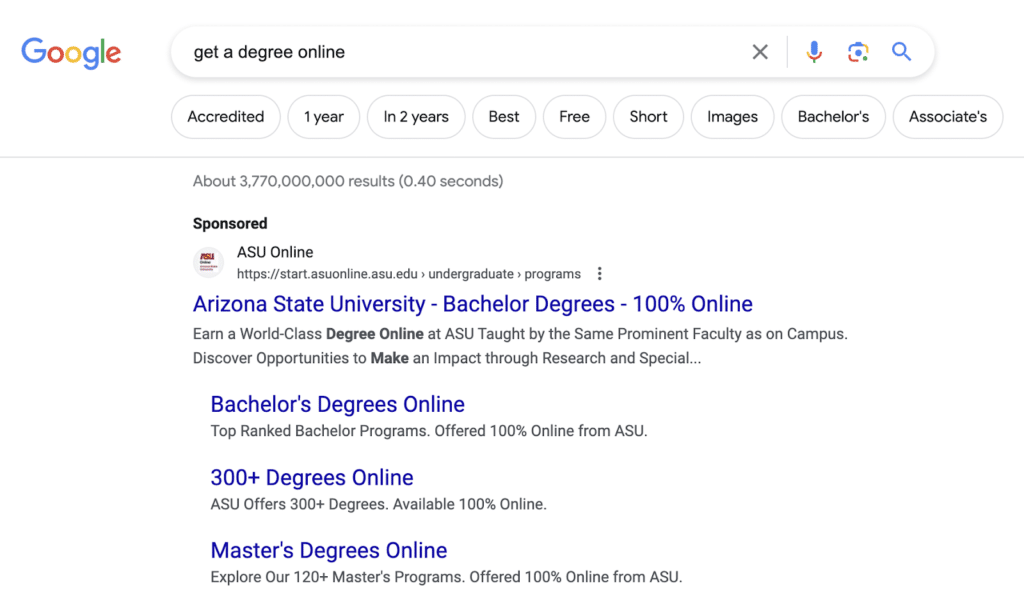
When searchers type “get a degree online,” Arizona State University’s PPC advertisement pops up. The additional links below are site link extensions, a type of ad extension. Ad extensions allow you to provide additional information and increase the chances of attracting clicks and conversions from prospective students.
💡 Higher Education PPC Marketing Tip:
Implement ad extensions to enhance your PPC campaigns. Consider using extensions like the site link extensions to direct users to specific pages on your website (e.g., programs, admissions, campus life), call extensions to encourage direct phone calls, location extensions to display your institution’s address and map, and review extensions to showcase positive reviews and ratings.
8. Utilizing First-Party (1P) Data
Unlike Third-Party data, First-Party data is unique to your school and owned by you.
You collect the data with explicit consent from your visitors through direct interaction with your website, text communications, or other marketing campaigns.
How does First-Party audience data help with higher-education marketing campaigns?
“First-Party audiences are every brand’s most important data sets for campaign success, and modeling from these segments has provided KORTX’s Higher Ed clients with their strongest conversion outcomes for new prospects.”

Collecting First-Party data allows you to personalize your marketing efforts. You can segment prospective students based on their academic interests and program preferences. This approach increases the chances of capturing the attention of the students most likely to enroll in your university.
⚡ 92% of leading marketers believe using First-Party data to continuously build an understanding of what people want is vital to growth.
💡 Higher Education First-Party Data Tip:
KORTX’s Axon Audience Manager simplifies the 1P data collection process by providing a user-friendly platform to collect and organize data from various sources.
With Axon, your school can create detailed prospective student profiles, track user interactions across your website, and use this data to personalize your brand messaging based on their interests and behaviors.
9. Using Lookalike Audiences
Lookalike audiences use advanced algorithms and machine learning to find and target individuals with similar characteristics and behaviors to your existing students.
This way, you can focus on prospects with higher conversion probability. Lookalike audiences help you prioritize resources on individuals more likely to engage with your institution and enroll instead of targeting a broad audience that may include less interested individuals.
KORTX creates lookalike audiences with Axon Audience Manager by using the First-Party data collected from Higher Ed websites and data stored in Axon.
It works like this:
- We identify diverse seed audiences, including general site visitors, application submitters, and majors and discipline researchers. These seed audiences represent individuals who have interacted with the institution’s website in various ways.
- We extract the personal attributes of prospective students or their parents from the First-Party data. Attributes like demographic information, browsing behavior, engagement levels, and other relevant data points.
- We measure and score the attributes to assess their significance and relevance for identifying potential prospects. This scoring process helps prioritize the prospects and indicates how likely they are to convert.
- Using the scored attributes, KORTX creates lookalike models representing the seed audiences’ attributes. These lookalike models identify individuals who resemble those who have engaged with the brand’s website in valuable ways.
Many universities have limited marketing budgets, so creating lookalike audiences can help stretch budgets further.
💡 Higher Education Lookalike Audiences Tip:
Start with a quality source audience. Choose a source audience that aligns with your desired audience, like a custom audience of existing students, website visitors, or engaged social media followers.
The more relevant and valuable your source audience, the better your lookalike audience will be.
10. Being Conversational
Conversational marketing is a popular trend as it offers a dialogue-driven approach for online users seeking personal interactions with brands. It uses various communication channels, such as live chat, social media messaging, chatbots, and email, to interact with prospects and customers.
Here are some ways you can use conversation marketing in the university setting:
- Providing instant assistance to prospective students, like answering questions about admissions, programs, campus life, financial aid, etc.
- Addressing student inquiries about course registration, academic advising, campus resources, and other student services.
- Offering personalized conversations through social media, email, or alumni portals and keeping alumni informed about events, fundraising campaigns, volunteer opportunities, and career services.
- Promoting events, such as open houses, campus tours, webinars, and career fairs, to provide event details, address inquiries, and gather feedback.
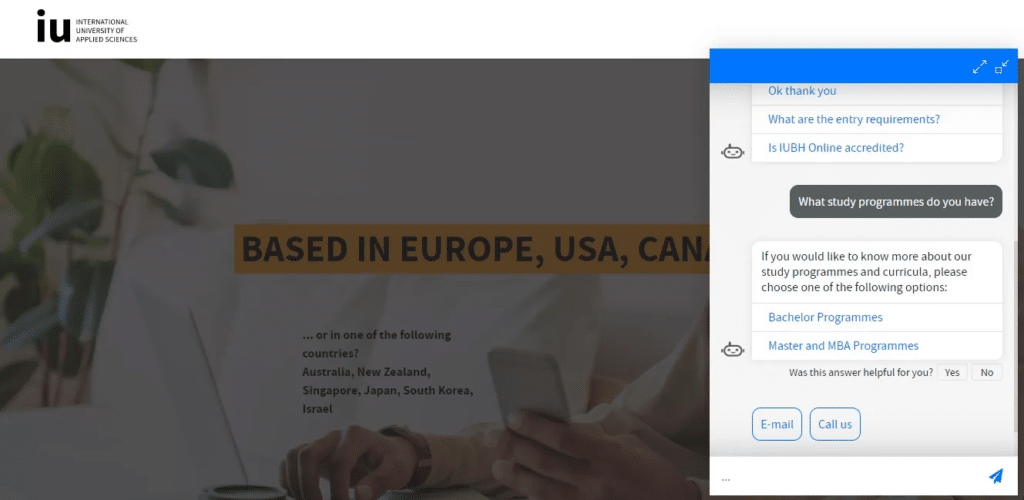
The International University of Applied Sciences in Germany uses a chatbot. Users can type what they need into the chatbot, and the bot will produce links to answer the user’s questions.
💡 Higher Education Conversational Marketing Tip:
Use chatbots to connect prospects with a student ambassador. Student ambassadors serve as official representatives and play a vital role in promoting the institution, sharing their experiences, and providing valuable insights into campus life.
11. Collaborating with Student Ambassadors
According to Nielsen’s research, 92% of people either entirely or partially believe word-of-mouth recommendations from family, coworkers, and friends about products or services, making their recommendations a trusted source.
Student ambassadors are your word-of-mouth university recommenders, as they can demonstrate what your institution is like from the inside out.
This also builds on Gen Z’s desire for authenticity and realistic marketing campaigns featuring actual students with honest perspectives. Find ambassadors with a strong social presence to attract potential students on why they should enroll in your institution.
Along with the conversational experience mentioned above, The University of Amsterdam has a page dedicated to International Ambassadors so prospects can chat directly through a user-friendly interface.
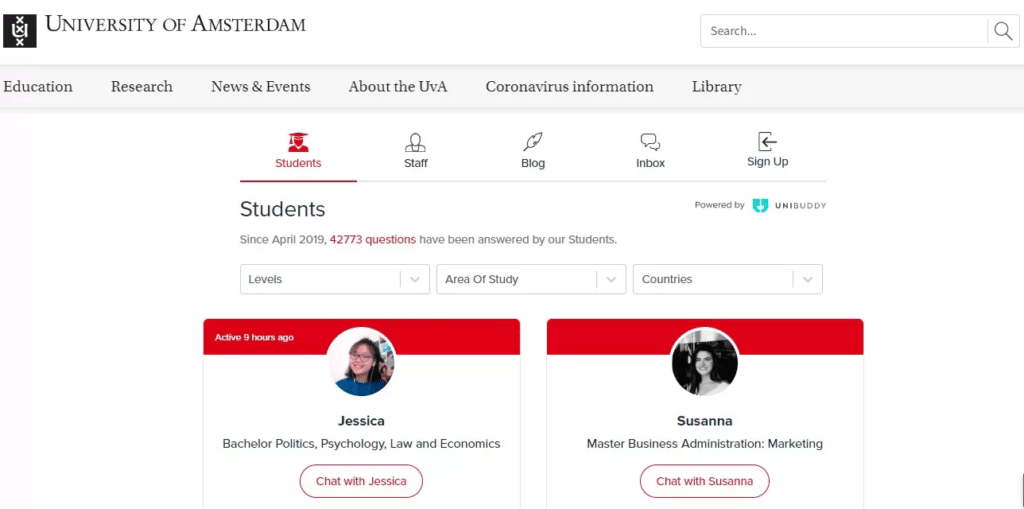
💡 Higher Education Student Ambassador Marketing Tip:
Have your ambassadors collaborate with social media influencers or popular student accounts to expand your reach and tap into your followers’ networks. This collaboration can involve hosting live Q&A sessions, taking over each other’s accounts, or co-creating content.
Incorporating relevant university-specific hashtags and geotags in the posts can increase visibility and reach a wider audience.
12. Using an Enrollment Funnel Approach
The enrollment funnel is a metaphor for categorizing prospective students’ stages to university enrollment.
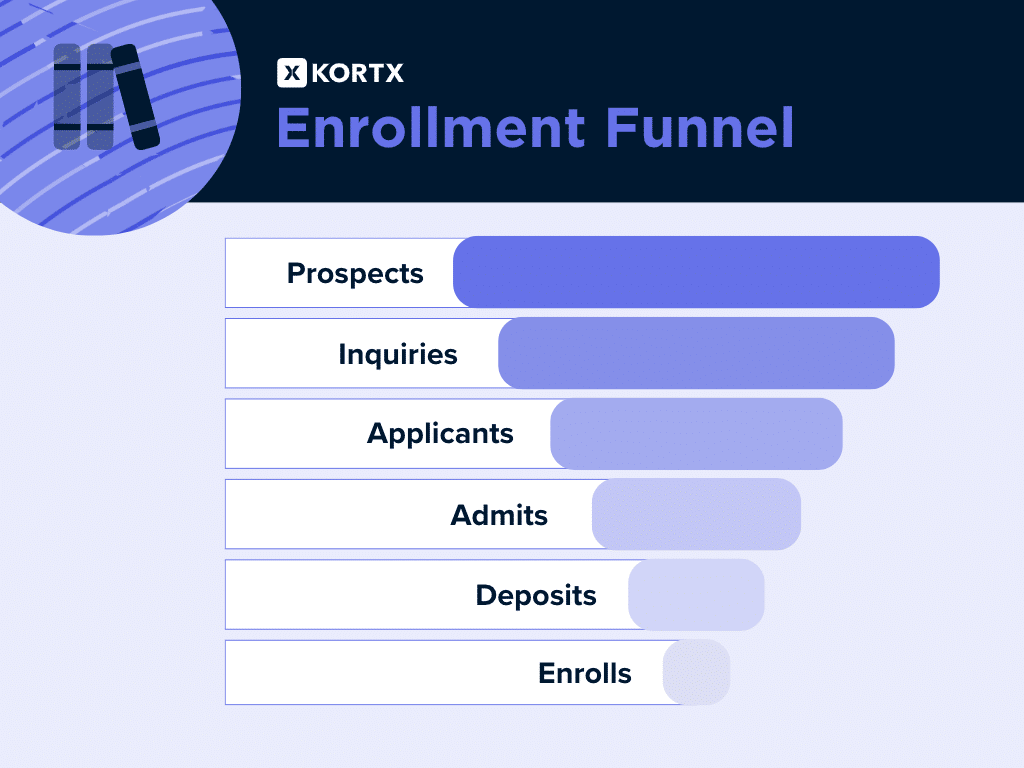
Typically, the enrollment funnel is used for planners wanting to develop the best recruitment strategies for each admissions process stage. In marketing, we’re starting to use it to target prospective students at each stage of the funnel process.
With university marketing, the idea is to constantly generate awareness: filling the pipeline for people to visit the website or apply and consistently building the funnel with new prospects.
For example, you can use social media and PPC ads to expand your reach overseas to attract international prospects. For example, you can also send targeted email marketing campaigns to high school seniors.
Tailoring your marketing messages to specific groups allows you to address their unique needs, interests, and pain points.
💡 Higher Education Full-Funnel Enrollment Tip:
Schools have traditionally purchased prospect lists and filled the top of the funnel with a large number of prospective students.
Adopt some omnichannel marketing strategies to move students through the admissions funnel from top to bottom, including building brand awareness with targeted campaigns, analyzing data to find out why students make enrollment decisions, and applying data to the highest-performing marketing channels (whether social media, SEO, or email).
13. Hosting Hybrid Events to Attract More Students
Virtual events have been wildly successful in a post-pandemic world, leading 58% of companies to say they produced the best results for their marketing efforts in the last year.
Higher ed institutions can adopt this strategy and use virtual events to engage new prospective students. Physical boundaries know no limits with online events, so international prospects can join in on the fun and learn about your university.
The University of Alberta hosts many online events and workshops to drive prospects.

You can offer in-person and online versions of the same event so no prospect feels left out.
💡 Higher Education Hybrid Events Tip:
Use interactive platforms and tools to create a seamless and engaging experience for in-person and virtual attendees. Incorporate features like live streaming, chat rooms, and Q&A sessions to facilitate real-time interactions and foster engagement.
These Higher Education Marketing Trends Are Here to Stay
The digital landscape, coupled with evolving student preferences and expectations, has necessitated the adoption of innovative approaches to reach and engage prospective students effectively.
Embracing technologies like virtual events, leveraging data-driven insights, prioritizing personalized experiences, and fostering authentic connections, allows higher education institutions to position themselves for long-term success in a competitive market.
A Student-Centered Strategy You Can Depend On
Partner with KORTX for tailored higher education marketing solutions prioritizing student engagement, data-driven insights, and impactful campaigns.
Josh Pheneger is an Account Strategist at KORTX. He likes to play golf, explore the city, and spend time in coffee shops.
